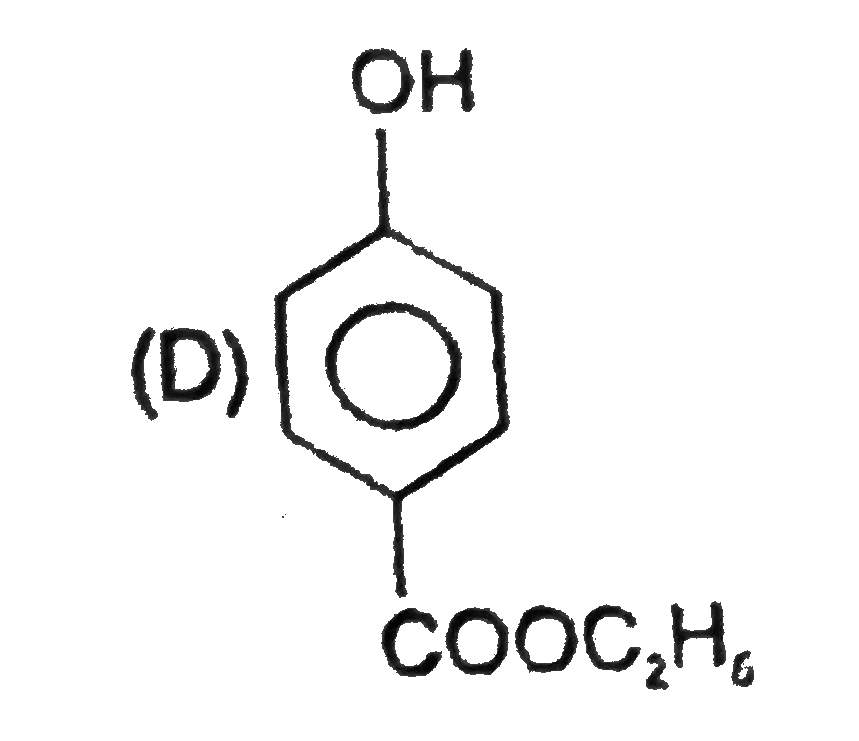Which of the folllwing can be form methane gas with methyl magnesium bromide?




The correct Answer is:2
To solve the question of which compound can form methane gas when reacted with methyl magnesium bromide (a Grignard reagent), we can follow these steps:
1. Identify Methyl Magnesium Bromide:
Methyl magnesium bromide (CH₃MgBr) is a Grignard reagent. It can be represented as CH₃⁻ (methyl anion) and MgBr⁺. The methyl anion is a strong nucleophile and a strong base.
2. Understanding the Reaction:
The reaction we are interested in is the deprotonation of a compound by the methyl anion (CH₃⁻) to produce methane (CH₄). The general reaction can be represented as:
R-H+CH−3→CH4+R−
Here, R-H is the compound we are reacting with.
3. Analyzing the Given Compounds:
We need to analyze the stability of the resulting carbanions (R⁻) formed after the deprotonation of each compound. The more stable the carbanion, the more likely it is for the reaction to occur.
4. Evaluating Each Option:
- Option 1: Cyclohexadiene
- The compound has sp² hybridized carbons and sp³ hybridized carbons. The methyl anion will preferentially deprotonate the sp³ carbon, forming a carbanion that can be stabilized by resonance. This compound is non-aromatic.
- Option 2: A compound with an sp³ hybridized carbon.
- The methyl anion can deprotonate this compound, forming a stable carbanion that can also be stabilized by resonance. This compound is likely to be aromatic or non-aromatic.
- Option 3: Another compound with an sp³ hybridized carbon.
- Similar to option 2, the methyl anion can deprotonate this compound, forming a stable carbanion.
- Option 4: A compound that is anti-aromatic.
- This compound will form a carbanion that is less stable due to anti-aromaticity. Thus, it is less likely to release methane.
5. Determining the Most Likely Candidate:
From the analysis, we can conclude that the compound that forms the most stable carbanion will be the one that can react with methyl magnesium bromide to produce methane.
- The aromatic compound (if present) would be the most stable, followed by non-aromatic compounds. Anti-aromatic compounds are the least stable and are unlikely to react favorably.
6. Conclusion:
Based on the stability of the carbanions formed and the ability of the methyl anion to deprotonate the compounds, the most likely candidate that can form methane gas with methyl magnesium bromide is the aromatic compound (if present). If no aromatic compound is present, the non-aromatic compound with the most stable carbanion will be the answer.
Final Answer:
The compound that can form methane gas with methyl magnesium bromide is the aromatic compound (if present) or the most stable non-aromatic compound.
Methyl magnesium bromide (CH₃MgBr) is a Grignard reagent. It can be represented as CH₃⁻ (methyl anion) and MgBr⁺. The methyl anion is a strong nucleophile and a strong base.
The reaction we are interested in is the deprotonation of a compound by the methyl anion (CH₃⁻) to produce methane (CH₄). The general reaction can be represented as:
R-H+CH−3→CH4+R−
Here, R-H is the compound we are reacting with.
We need to analyze the stability of the resulting carbanions (R⁻) formed after the deprotonation of each compound. The more stable the carbanion, the more likely it is for the reaction to occur.
- Option 1: Cyclohexadiene
- The compound has sp² hybridized carbons and sp³ hybridized carbons. The methyl anion will preferentially deprotonate the sp³ carbon, forming a carbanion that can be stabilized by resonance. This compound is non-aromatic.
- Option 2: A compound with an sp³ hybridized carbon.
- The methyl anion can deprotonate this compound, forming a stable carbanion that can also be stabilized by resonance. This compound is likely to be aromatic or non-aromatic.
- Similar to option 2, the methyl anion can deprotonate this compound, forming a stable carbanion.
- This compound will form a carbanion that is less stable due to anti-aromaticity. Thus, it is less likely to release methane.
From the analysis, we can conclude that the compound that forms the most stable carbanion will be the one that can react with methyl magnesium bromide to produce methane.
Based on the stability of the carbanions formed and the ability of the methyl anion to deprotonate the compounds, the most likely candidate that can form methane gas with methyl magnesium bromide is the aromatic compound (if present). If no aromatic compound is present, the non-aromatic compound with the most stable carbanion will be the answer.
The compound that can form methane gas with methyl magnesium bromide is the aromatic compound (if present) or the most stable non-aromatic compound.
Topper's Solved these Questions
- HYDROCARBONSBOOK - AAKASH INSTITUTECHAPTER - HYDROCARBONSEXERCISE - Assignment(Section - C) (Previous Years Questions)
69 Videos
- HYDROCARBONSBOOK - AAKASH INSTITUTECHAPTER - HYDROCARBONSEXERCISE - Assignment(Section - D) (Assertion -Reason Type Question)
24 Videos
- HYDROCARBONSBOOK - AAKASH INSTITUTECHAPTER - HYDROCARBONSEXERCISE - Assignment(Section - A) (Obejctive type question)
55 Videos
- HALOALKANES AND HALOARENES BOOK - AAKASH INSTITUTECHAPTER - HALOALKANES AND HALOARENES EXERCISE - ASSIGNMENT SECTION -D
15 Videos
- HYDROGENBOOK - AAKASH INSTITUTECHAPTER - HYDROGENEXERCISE - ASSIGNMENT (SECTION - D) (Assertion-Reason Type question)
15 Videos
Similar Questions
Knowledge Check
Which compound among the following on reaction with ethyl magnesium bromide gives ethane ?
AC2H5CNBCH3CHOCsolid CO2DH2OWhich of the following ester on reaction with methyl magnesium chloride produces a secondary alcohol ?
AEthyl acetateBMethyl butyrateCIsopropyl propanoateDEthylmethanoateWhich of the following compounds would liberate two moles of methane when treated with methyl magnesium bromide ?
ACH3−C∣OHH−CH2−C=CHBCH3−C∣∣O−CH2−CH2OHCCH3−C∣∣O−CH3∣CH−C∣∣O−CH3D
Consider the following statement acetophenone can be prepared by
(1) Oxidation of l-phenylthanol
(2) Recation of banzalthanol with methyl magnesium bromide
(3) Fridel-Cafts reaction of benzene with aceptyl choride
(4) Distillation of calcium benzoate
View SolutionWhich of the following substance will not poduce methane by its treatment with methyl magnesium iodide?
View SolutionEthyl acetate is obtained when methyl magnesium bromide reacts with:
View SolutionThe compound obtained by the hydrolysis of the adduct formed by the reaction of ethyl magnesium bromide and acetadehyde is :
View SolutionBenzonitrile and phenyl magnesium bromide produces
View Solution
